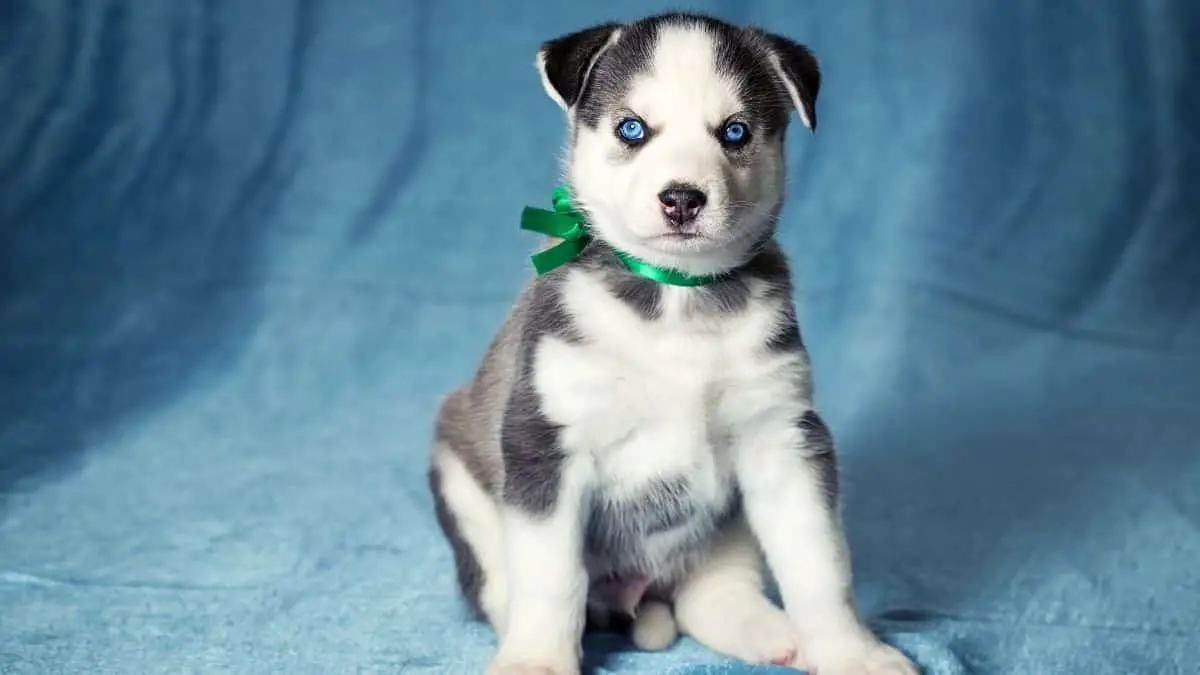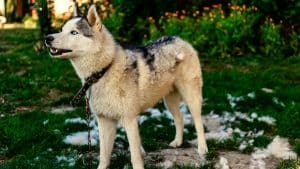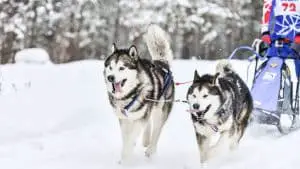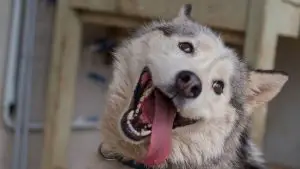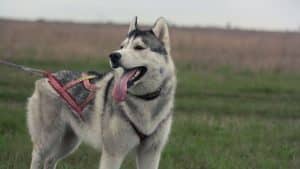Husky Puppies And Their Ears: 6 Things You Should Know
Dog’s ears can hear up to 45kHz, while a human ear can register sounds only up to 20 kHz. Since they can hear a higher frequency than humans, dogs usually have a different perception of the world acoustically. Their ear canals are narrow and long and travel into the deeper parts of the ear. You can tell if your dog is paying attention, scared, relaxed, or happy by the way its ears move. You can determine their level of engagement by closely watching the ear movements.
Huskies are known for their perked-up and upright ear shape that is key to their identity. However, all huskies are born with floppy ears since the bones and muscles haven’t fully- formed around their ears. Husky Puppies’ ears start to stand up from 6 weeks. Huskies are generally very hygienic dogs, and self-cleans like cats do, so you won’t have to clean their ears too often. Cleaning their ears too frequently can cause more harm than good and may lead to a proneness for ear infections.
When it comes to your husky’s ears, there are six things you should know:
Table of Contents
Using their ears for communication
Huskies use their ears to communicate their feeling to their owners. Feelings of happiness, aggression, frustration, attention, etc., can all be displayed through different ear movements. All dogs have over a dozen muscles in their ears that help them move, wiggle, and tilt their ears easily.
You can tell that a husky is happy when the ears are perked-up or sad when the ears are flattened and pulled-back. You can learn more about your husky’s body language on Husky & Body Language: 10 Important Things To Remember.
Perked-up husky ears
The ears of all puppies stand up at a certain age. The ears of husky puppies perk up when they complete six or seven months of age. It takes time for their ears to stand up because the bones and cartilages in the ear are still growing when the husky is still a puppy. As they grow older, these cartilages become more substantial and firmer.
You should take care and check the timeline when the husky’s ears perk up because they may be delayed sometimes due to weakness in the bones and cartilages. This weakness can cause long-term hearing problems and ear infections in your husky.
It isn’t easy to precisely point out the timeline in which your puppy’s ears will become erect. In growing puppies, ear growth tends to be quite erratic. One moment it may seem like they are starting to perk up but then they become floppy again. Sometimes this process is delayed due to teething. The husky’s ears tend to droop down when they are teething, which can take several months.
Teething puts a lot of stress on the puppy’s jaws and facial muscles, responsible for perking up their ears. Thus, naturally, this process gets delayed because of excess pressure on these muscle groups. But within 6-7 months, your puppy should have fully perked up ears.
Whether your husky’s ears will become erect and perked up or not depends mainly on the breeding as well. Your husky can have floppy ears if the parents also had floppy ears. Sometimes their ears can be different from one another- one can be raised and pointed, while the other is floppy. The research behind this phenomenon shows that your husky is just submissive, or if it is a more continual occurrence, it could be due to an underdeveloped pinna in the husky’s ear. There’s no need to worry about such under-development as it does not hinder their hearing or bodily activities.
If you wait it out, they can grow to become pointed in their own time. In about 6-7 months, if your husky still doesn’t have the signature perky ears, you can visit the veterinarian to research what could be causing the delay in growth.
A healthy diet for healthy ears
A healthy diet is necessary for your husky’s growth, including the ears. Especially since puppies are fragile and prone to many illnesses, they need to be taken care of with the proper diet, including supplements. Their bone structures are also not fully formed and firm when they are puppies; that’s why it is recommended to feed your puppies calcium supplements when they are young. It will strengthen their bones, including the bones and cartilages in their ears. A calcium deficiency will hinder ear growth in puppies.
Many breeders recommend that you feed your huskies high-quality food, including all the necessary supplements they need for a healthy life. If essential nutrients are missing from their food, you should give them supplements such as vitamins, antioxidants, and even minerals.
A husky’s diet should be rich in protein and healthy fats, including calcium, which is excellent for bones, especially in this developing stage. Glucosamine as a supplement is known to provide the right nutrition to maintain healthy cartilages in dogs. However, it is better to take the advice of your veterinarian before diving into this particular supplement. Read up on husky’s health care on https://www.akc.org/dog-breeds/siberian-husky/
Cleaning husky’s ears
The frequency at which you clean your husky’s ears depends on the type of lifestyle you have with your husky. If you go for regular walks and have playtime indoors or in the neighborhood itself, then you won’t need to clean out their ears as much.
On the other hand, if you go for long treks and hikes through muddy and wet trails, you will have to clean the ears more frequently. Even if you don’t have a routine, the minimum ear cleaning a husky should get at least once per month.
Because of their perky and pointed ear shape, they don’t retain a lot of moisture and dirt from the environment naturally; this means that you don’t have to clean them daily. Instead, cleaning your husky’s ears too frequently can cause ear infections and increase sensitivity.
Clipping the hair inside the ear will also ensure that no ear infections will pass on a disease to your husky. After going for a swim or after bath time, you should dry the ears properly to get rid of excess moisture that might cause an ear infection.
Ear infections in huskies
Check for symptoms of ear infections in huskies regularly. Some of the main symptoms include excessive shaking of the head, a pungent odor coming from the ears, swelling, redness, and itchiness. Your husky may whine from pain when they have ear infections. Special care should be taken when they are younger since they have floppy ears and tend to help more moisture than perked-up ears.
Husky puppies are also fragile and generally have low immunity; hence, they are prone to contracting ear infections a lot easier. If the condition is complicated or very severe, it can take a long time to treat and cure, whereas you can quickly take care of minor ear infections in less than a week or two.
Cleaning your puppy’s ears an adequate amount is the best way to manage and prevent ear infections. You should check for mineral deficiency in them and provide the appropriate supplements that will ensure that your husky’s ears stay healthy. Since huskies have per-up ears, it aids in better air circulation and prevents bacteria or fungus from lingering inside the ear canal. For more information on their care you can visit https://www.akc.org/dog-breeds/siberian-husky/#breed-care
What not to do when it comes to your husky’s ears
- Scrubbing the husky’s head while bathing them can also hinder their ear growth. You have to be very gentle with them even when cleaning.
- Snuggling with your husky can also stunt the process of ear growth or even damage the cartilages.
- Caressing and massaging your husky’s ears may also do their ears more damage as all the bones and muscles are soft and delicate. Their shape and density are frail, so you have to try not to put any pressure on their ears, even if it’s caressing and massaging.
While some people may suggest that you massage their ears to increase blood flow, this claim is not 100% validated, so it would be better to play it safe and avoid any rigorous touching of their ears when they are still in the process of growth.
- Taping huskies’ ears is a common practice among owners. Some people believe that taping their husky’s ears will help their ears grow into perky, pointed ears. There are many risks involved in this particular technique because taping their ears in the wrong position can cause the cartilages, bones, and muscles in this area to grow in the wrong place; this does them more harm than good.
The best thing you can do for your husky to help in the expected growth of their physical development is to ensure that you feed them a proper diet and also a healthy lifestyle altogether. Take your huskies out for walks and have routine playtime with your huskies. This activity will help strengthen their immune system and relieve stress.
You should ensure that you are not putting stress or tension around the husky’s ears and general head area during playtime. Playing around with their ears too much can result in damage to their cartilage which is very fragile. Protecting your puppies from experiencing any stress is a crucial step in improving their lifestyle and, ultimately, their physical development.

